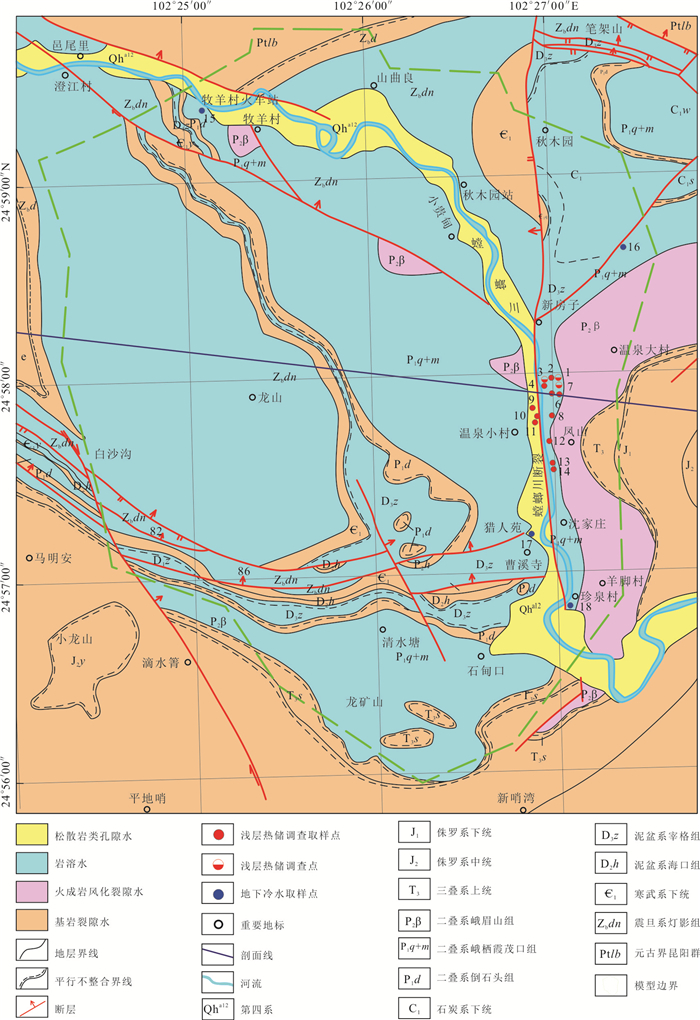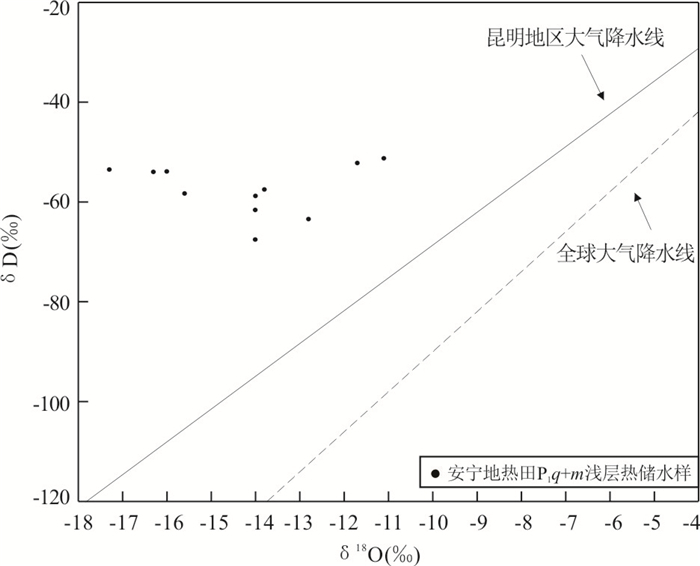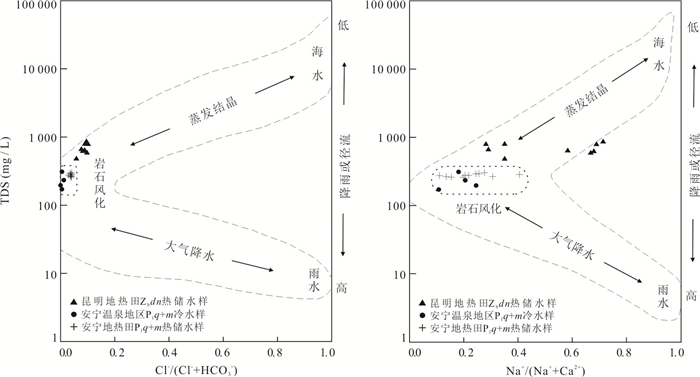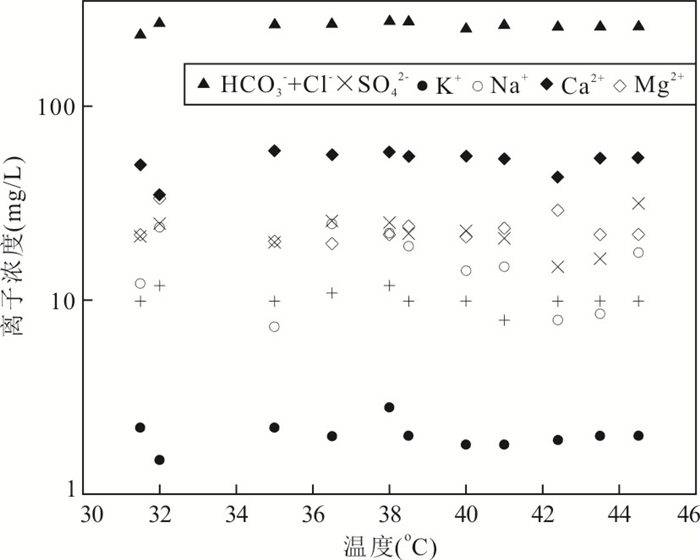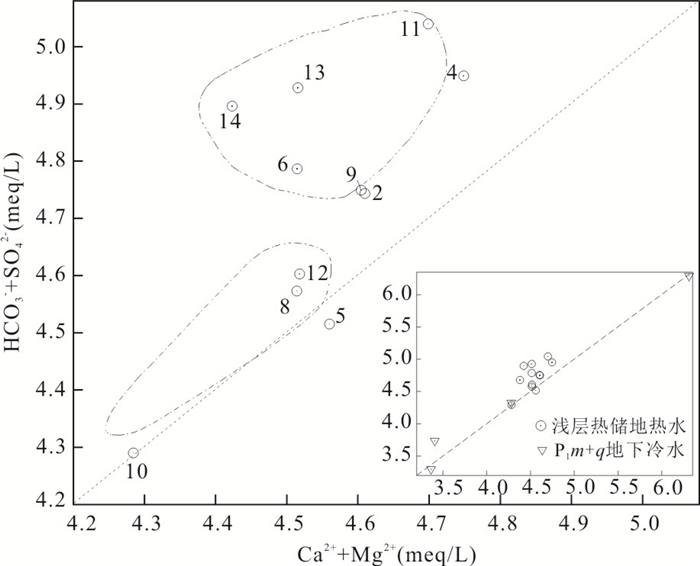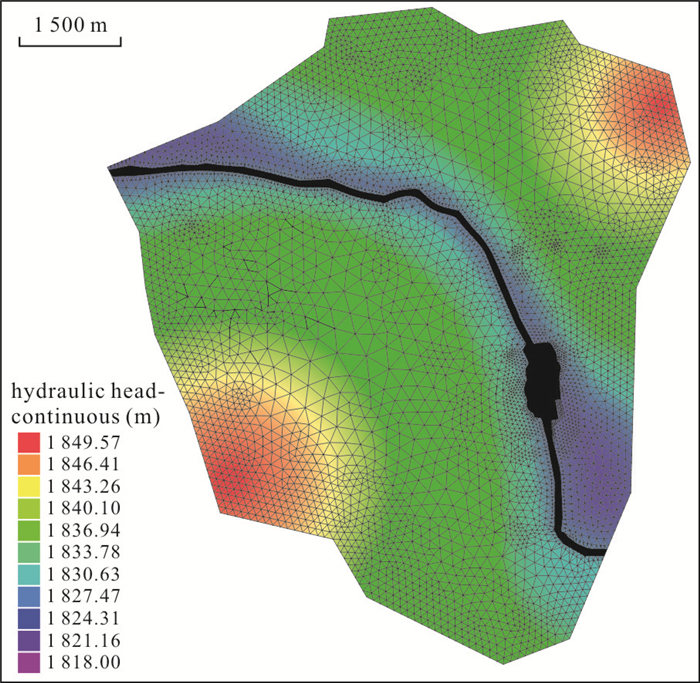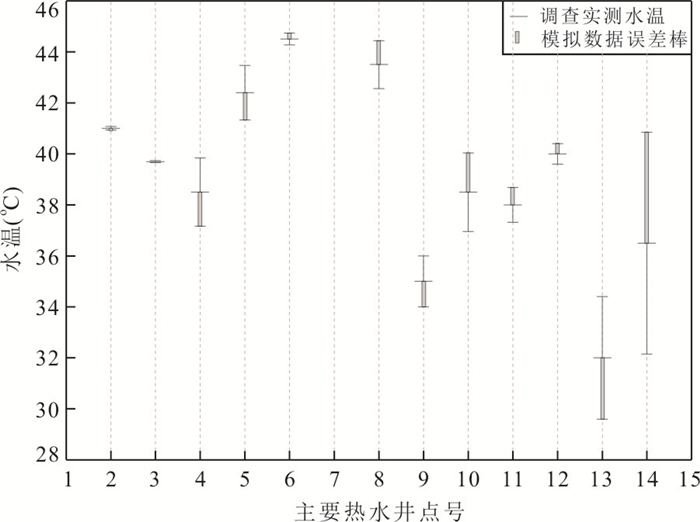Hydro-Geochemistry of Anning Geothermal Field and Flow Channels Inferring of Upper Geothermal Reservoir
-
摘要: 碳酸盐岩淡水热储层在我国西南地区广泛分布,安宁地热田毗邻昆明地热田西侧约40 km,是具有垂向双层热储结构的低温地热田.在深部地层缺乏钻探资料时,为了探究地热田成因,寻找深部热储向浅部热储的补给通道,使用了以下研究方法:(1)通过类比昆明地热田确定灯影组深部热储的水化学特征,(2)从水岩作用、水化学类型和主要离子相关性分析方面入手,阐述深部热储与浅部栖霞茅口组热储水化学特征的区别与联系,发现可用钠离子作为热水通道的指示因子,(3)以包括开采现状、实测温度和通道位置的数值反演模型验证通道的合理性.分析显示,浅部地热水为混合水,水化学类型(HCO3-Ca·Mg型)明显受同层冷水控制,与深部地热水离子浓度差别大.浅部热储水各点的地热水化学特征差异小,仅钠离子浓度分布可与地热田温度分区和开发利用情况相呼应.对于补给通道的水化学数据分析结果和数值模拟结果嵌合较好,说明采用以钠离子分布为主的综合分析方法所推断的补给通道位置较为合理.Abstract: Carbonatite geothermal reservoir with freshwater is widespread in Southwest China. Anning low temperature geothermal field, which has a dual vertical structure, is approximately 40 km adjacent to the west of Kunming geothermal field. For exploring formation of geothermal field and discovering flow channel through which deeper thermal water flows upwards to the upper reservoir under a poor-drilling data condition, three methods are employed in this paper. (1) Hydro-geochemical characteristics of the deeper reservoir (Dengying Formation) is determined with an analogy to the similar reservoir (also Dengying Formation) of Kunming geothermal field. (2) Sodium is recognized as a possible indicator of flow channel to the upper reservoir by elaborating the difference and connection between upper reservoir (Qixia-Maokou Formation) and deeper reservoir in consideration of water-rock interaction, hydrochemistry type and correlation of main ions. (3) An inverse numerical model, including exploitation quantity and measured thermal water temperature, is used to verify the rationality of channel location. Thermal water in upper reservoir is mixture, whose ion concentration is distinctive from the deeper thermal water, and its hydrochemistry type (HCO3-Ca·Mg) is controlled by cold water around obviously. There are slight differences of hydrochemical characteristics among geothermal producing wells, except for sodium distribution, which is corresponding with the distribution of water temperature and exploitation status. The locations of flow channel obtained through hydrochemical data are well matched with numerical simulation results, which suggests that the inferring of flow channels through synthetical analyses mainly based upon the distribution of sodium may be feasible.
-
表 1 安宁地热田15组地下冷热水样分析结果
Table 1. Chemical composition of 15 groundwater samples of Anning geothermal field
编号 名称 水温(℃) $ \mathrm{p}\mathrm{H} $ $ \mathrm{\delta }{}^{2}\mathrm{H} $ $ \mathrm{\delta }{}^{18}\mathrm{O} $ $ \mathrm{T}\mathrm{D}\mathrm{S} $ $ \mathrm{H}\mathrm{C}{\mathrm{O}}_{3}^{-} $ $ \mathrm{C}{\mathrm{l}}^{-} $ $ \mathrm{S}{\mathrm{O}}_{4}^{2-} $ $ {\mathrm{K}}^{+} $ $ \mathrm{N}{\mathrm{a}}^{+} $ $ \mathrm{C}{\mathrm{a}}^{2+} $ $ \mathrm{M}{\mathrm{g}}^{2+} $ 离子平衡检验(%) ‰ (mg/L) 1 军区疗养院 43.0 2 云南省干部疗养院1 41.0 7.4 ‒57.5 ‒13.8 277.6 262.8 7.9 20.9 1.8 14.9 53.5 23.5 3.28 3 云南省干部疗养院2 39.7 4 云南省干部疗养院3 38.5 7.5 ‒53.9 ‒16.0 293.0 273.8 9.9 22.1 2.0 19.0 55.3 24.1 3.67 5 停车场井 42.4 7.4 ‒58.8 ‒14.0 260.8 256.5 9.9 14.9 1.9 7.9 43.3 29.1 1.62 6 天下第一汤 44.5 7.5 ‒52.2 ‒11.7 291.2 258.1 9.9 31.6 2.0 17.6 54.4 21.8 1.55 7 温泉别墅 44.0 8 温泉宾馆 43.5 7.1 ‒63.4 ‒12.8 265.9 258.1 9.9 16.4 2.0 8.5 54.4 21.8 0.85 9 会议中心 35.0 7.6 ‒53.5 ‒17.3 275.5 264.4 9.9 19.9 2.2 7.3 59.0 20.1 ‒0.50 10 温泉小村 31.5 7.2 ‒58.3 ‒15.6 259.5 234.5 9.9 21.4 2.2 12.2 49.8 21.8 3.20 11 温泉街道办 38.0 7.4 ‒67.5 ‒14.0 303.7 275.4 11.9 25.2 2.8 22.2 58.1 21.8 3.25 12 云涛酒店 40.0 7.5 ‒54.0 ‒16.3 278.3 251.8 9.9 22.8 1.8 14.2 55.3 21.3 2.98 13 摩崖石刻1 32.0 7.5 ‒61.6 ‒14.0 284.6 269.1 11.9 24.8 1.5 23.8 35.0 33.6 3.00 14 摩崖石刻2 36.5 7.3 ‒51.3 ‒11.1 266.7 266.0 10.9 25.7 2.0 24.8 56.2 19.6 3.25 15 牧羊火车站 20.0 7.8 171.5 192.0 1.0 7.1 0.8 3.9 32.3 21.3 3.41 16 铁路武装部 21.0 7.5 310.9 350.9 2.0 26.0 0.8 5.7 25.8 61.0 1.77 17 猎人苑 18.0 7.7 196.4 215.6 < 0.99 9.5 0.7 12.0 36.9 19.0 2.81 18 珍泉村 19.0 7.2 233.7 245.5 3.0 14.3 0.7 10.0 38.7 28.5 3.57 表 2 昆明地热田地下热水常规指标
Table 2. Chemical compositions of thermal water in Kunming geothermal field
矿化度(mg/L) $ \mathrm{p}\mathrm{H} $ K+ Na+ Ca2+ Mg2+ HCO3‒ SO42‒ Cl- (mg/L) 130~720 6.8~8.2 6.0~24 1.7~135.0 15.24~88.32 7.08~40.94 299.79~462.9 2.0~196.0 1.15~40.13 注:改自徐世光(2001). 表 3 数值模型水头计算值与观测值(m)
Table 3. Simulating hydraulic head of numerical model and observing head
编号 名称 观测水头 计算水头 误差 3 云南省干部疗养院2 1 823.8 1 822.05 ‒1.75 5 停车场井 1 823.6 1 823.26 ‒0.34 6 天下第一汤 1 823.1 1 823.34 0.24 10 温泉小村 1 821.5 1 822.54 1.04 12 云涛酒店 1 822.7 1 822.09 ‒0.61 14 摩崖石刻2 1 821.5 1 822.39 0.89 -
An, Q.S., Wang, Y.Z., Zhao, J., et al., 2016. Direct Utilization Status and Power Generation Potential of Low-Medium Temperature Hydrothermal Geothermal Resources in Tianjin, China: A Review. Geothermics, 64: 426-438. https://doi.org/10.1016/j.geothermics.2016.06.005 Burns, E.R., Ingebritsen, S.E., Manga, M., et al., 2016. Evaluating Geothermal and Hydrogeologic Controls on Regional Groundwater Temperature Distribution. Water Resources Research, 52: 1328-1344. https://doi.org/10.1002/2015WR018204 Chen, B. C., Perdana, T., Kuo, L.W., 2021. Fluid Flow and Fault-Related Subsurface Fractures in Flate and Metasandstone Formations: A Case Study of the Jentse Geothermal Area, Taiwan. Geothermics, 89. https://doi.org/10.1016/j.geothermics.2020.101986 Chen, M.X., Wang, J.Y., 1994. Review and Prospect on Geothermal Studies in China. Acta Geophysica Sinica, 37(S1): 320-338 (in Chinese with English abstract). http://en.cnki.com.cn/Article_en/CJFDTOTAL-DQWX4S1.029.htm Cheng, X.F., Xu, S.G., Zhang, S.T., 2008. Characteristics of Geothermal Geology and Genetic Model of the Anning Hot Spring in Yunnan Province. Hydrogeology & Engineering Geology, 5: 124-128 (in Chinese with English abstract). http://en.cnki.com.cn/Article_en/CJFDTOTAL-SWDG200805032.htm Craig, H., 1961. Isotopic Variations in Meteoric Waters. Science, 133(3465): 1702-1703. https://doi.org/10.1126/science.133.3465.1702 Fabbri, P., Pola, M., Piccinini, L., et al., 2017. Monitoring, Utilization and Sustainable Development of a Low-Temperature Geothermal Resource: A Case Study of the Euganean Geothermal Field (NE, Italy). Geothermics, 70: 281-294. https://doi.org/10.1016/j.geothermics.2017.07.002 Guo, S.S., Zhu, C.Q., Qiu, N.S., et al., 2020. Formation Conditions and Favorable Areas for the Deep Geothermal Resources in the Xiong'an New Area. Acta Geologica Sinica, 94(7): 2026-2035 (in Chinese with English abstract). Hu, H., Wang, J.L., 2015. On Characteristics of Hydrogen and Oxygen Isotope in Precipitation in Yunnan and Analysis of Moisture Sources. Journal of Southwest China Normal University (Natural Science Edition), 40(5): 142-149 (in Chinese with English abstract). http://en.cnki.com.cn/Article_en/CJFDTOTAL-XNZK201505025.htm Ji, H.C., Li, H.Q., Chen, L., et al., 2017. Composition and Resource Prediction of the Nanxiang Basin Geothermal System: A Case Study from the Biyang and Nanyang Sags. Earth Science Frontiers, 24(3): 199-209 (in Chinese with English abstract). http://en.cnki.com.cn/Article_en/CJFDTOTAL-DXQY201703023.htm Rao, N. S., 2002. Geochemistry of Groundwater in Parts of Guntur District, Andhra Pradesh, India. Environmental Geology, 41(5): 552-562. https://doi.org/10.1007/s002540100431 Song, X. Q., Peng, Q., Duan, Q.S., et al., 2019. Hydrochemistry Characteristics and Origin of Geothermal Water in Nothereastern Guizhou. Earth Science, 44(9): 2874-2886 (in Chinese with English abstract). http://en.cnki.com.cn/Article_en/CJFDTotal-DQKX201909006.htm Sun, Z.J., Gao, Z.J., Wang, X.F., et al., 2018. Exploration of Mineral Water Outcropping Pattern in the Mountainous Area of South Jiangxi. Acta Geoscientica Sinica, 39(5): 565-572 (in Chinese with English abstract). http://www.researchgate.net/publication/331686443_Exploration_of_Mineral_Water_Outcropping_Pattern_in_the_Mountainous_Area_of_South_Jiangxi Wang, G.L., Zhang, W., Liang, J.Y., et al., 2017. Evaluation of Geothermal Resources Potential in China. Acta Geoscientica Sinica, 38(4): 449-459 (in Chinese with English abstract). http://en.cnki.com.cn/Article_en/CJFDTOTAL-DQXB201704002.htm Wang, J.A., Xu, Q., Zhang, W.R., 1990. Heat Flow Data and Some Geologic-Geothermal Problems in Yunnan Province. Seismology and Geology, 12(4): 367-377 (in Chinese with English abstract). http://www.en.cnki.com.cn/Article_en/CJFDTOTAL-DZDZ199004012.htm Wang, J.Y., 2015. Geothermics and Its Applications. Science Press, Beijing, 58 (in Chinese with English Foreword). Wang, X.W., Wang, T.H., Zhang, X., et al., 2019. Genetic Mechanism of Xiwenzhuang Geothermal Field in Taiyuan Basin. Earth Science, 44(3): 1042-1056 (in Chinese with English abstract). http://en.cnki.com.cn/Article_en/CJFDTotal-DQKX201903030.htm Wang, Y., Kang, X.B., Zhang, H., et al., 2016. The Genesis and Extension of Kunming Geothermal Field. Carsologica Sinica, 35(2): 125-133 (in Chinese with English abstract). http://en.cnki.com.cn/Article_en/CJFDTOTAL-ZGYR201602001.htm Xu, Q., Wang, J.A., Wang, J.Y., 1992. A Compound and Superimposed Thermal Structure of the Lithosphere in the Continental Collision Orogens-A Case Study of the Sanjiang Region of Yunnan. Geological Review, 38(6): 540-545 (in Chinese with English abstract). http://en.cnki.com.cn/Article_en/CJFDTOTAL-DZLP199206011.htm Xu, S.G., 2001. Modeling Study on Kunming Geothermal Field (Dissertation). China University of Geosciences, Beijing, 28-42 (in Chinese with English abstract). Xu, Z.P., Wang, F.Y., Jiang, L., et al., 2018. The Depth of Moho Interface and Crustal Thickness in Sichuan-Yunnan Region, China. Seismology and Geology, 40(6): 1318-1331 (in Chinese with English abstract). http://en.cnki.com.cn/Article_en/CJFDTotal-DZDZ201806009.htm Yang, J.H., Gao, J.C., 2008. Geothermal Geological Feature Analysis and Research of Anning Hot Spring. Journal of Kunming University of Science and Technology (Science and Technology), 33(5): 1-6 (in Chinese with English abstract). http://en.cnki.com.cn/Article_en/CJFDTOTAL-KMLG200805000.htm Yu, N., Hu, X.Y., Li, J., et al., 2017. Electrical Structure of the Longling Area in Western Yunnan and Its Effect on Route Selection of the Dali-Ruili Railway. Chinese Journal of Geophysics, 60(6): 2442-2455 (in Chinese with English abstract). http://www.researchgate.net/publication/319245174_Electrical_structure_of_the_Longling_area_in_western_Yunnan_and_its_effect_on_route_selection_of_the_Dali-Ruili_railway Yuan, J.F., Deng, G.S., Xu, F., et al., 2016. Hydrogeochemical Characteristics of Karst Groundwater in Northern Part of the City of Bijie. Hydrogeology & Engineering Geology, 43(1): 12-20 (in Chinese with English abstract). http://en.cnki.com.cn/Article_en/CJFDTOTAL-SWDG201601004.htm Zhang, G.Y., Liu, D.M., Zhang, J.Q., et al., 2020. Analysis of Structural Controls of Geothermal Resources in the NW-SE Trending Boluo-Dayawan Fault Depression in Huizhou City, Guangdong Province. Earth Sciences Frontiers, 27(1): 63-71 (in Chinese with English abstract). Zhang, L.H., Guo, F.G., Sano, Y., et al., 2017. Flux and Genesis of CO2 Degassing from Volvanic-Geothermal Fields of Gulu-Yadong Rift in the Lhasa Terrane, South Tibet: Constraints on Characteristics of Deep Carbon Cycle in the India-Aisa Continent Subduction Zone. Journal of Asian Earth Sciences, 149: 110-123. https://doi.org/10.1016/j.jseaes.2017.05.036 Zhang, X. B., Hu, Q. H., 2018. Development of Geothermal Resources in China: A Review. Journal of Earth Science, 29(2): 452-467. https://doi.org/10.1007/s12583-018-0838-9 Zhang, Y., Feng, J.Y., He, Z.L., et al., 2017. Classification of Geothermal Systems and Their Formation Key Factors. Earth Science Frontiers, 24(3): 190-198 (in Chinese with English abstract). http://en.cnki.com.cn/Article_en/CJFDTOTAL-DXQY201703022.htm 陈墨香, 汪集旸, 1994. 中国地热研究的回顾与展望. 地球物理学报, 37(S1): 320-338. 程先锋, 徐世光, 张世涛, 2008. 云南省安宁温泉地热地质特征及成因模式. 水文地质工程地质, 5: 124-128. http://www.cnki.com.cn/Article/CJFDTotal-SWDG200805032.htm 郭飒飒, 朱传庆, 邱楠生, 等, 2020. 雄安新区深部地热资源形成条件与有利区预测地质学报, 94(7): 2026-2035. http://www.cqvip.com/QK/95080X/202007/7102425304.html 胡菡, 王建力, 2015. 云南地区大气降水中氢氧同位素特征及水汽来源分析. 西南师范大学学报(自然科学版), 40(5): 142-149. 季汉成, 李海泉, 陈亮, 等, 2017. 南襄盆地地热系统构成及资源量预测: 以泌阳、南阳凹陷为例. 地学前缘, 24(3): 199-209. http://www.cnki.com.cn/Article/CJFDTotal-DXQY201703023.htm 宋小庆, 彭钦, 段启杉, 等, 2019. 黔东北地区地热水化学特征及起源. 地球科学, 44(9): 2974-2886. doi: 10.3799/dqkx.2019.146 孙智杰, 高宗军, 王新峰, 等, 2018. 赣南山区矿泉水出露模式探讨. 地球学报, 39(5): 565-572. http://www.cnki.com.cn/Article/CJFDTotal-DQXB201805007.htm 王贵玲, 张薇, 梁继运, 等, 2017. 中国地热资源潜力评价. 地球学报, 38(4): 449-459. http://www.cnki.com.cn/Article/CJFDTotal-DQXB201704002.htm 汪缉安, 徐青, 张文仁, 1990. 云南大地热流及地热地质问题. 地震地质, 12(4): 367-377. 汪集旸, 2015. 地热学及其应用. 北京: 科学出版社, 58. 汪新伟, 王婷灏, 张瑄, 等, 2019. 太原盆地西温庄地热田的成因机制. 地球科学, 44(3): 1042-1056. doi: 10.3799/dqkx.2018.387 王宇, 康晓波, 张华, 等, 2016. 昆明地热田的成因与外延. 中国岩溶, 35(2): 125-133. http://www.cnki.com.cn/Article/CJFDTotal-ZGYR201602001.htm 徐青, 汪缉安, 汪集旸, 1992. 大陆碰撞造山带复合叠加型岩石圈热结构——以云南三江地区为例. 地质论评, 38(6): 540-545. doi: 10.3321/j.issn:0371-5736.1992.06.012 徐世光, 2001. 昆明地热田模型研究(博士学位论文). 北京: 中国地质大学, 28-42. 徐志萍, 王夫运, 姜磊, 等, 2018. 川滇地区莫霍面深度和地壳厚度. 地震地质, 40(6): 1318-1331. http://www.cnki.com.cn/Article/CJFDTotal-DZDZ201806009.htm 杨金和, 高俊彩, 2008. 安宁温泉地热区地热地质特征分析与研究. 昆明理工大学学报(理工版), 33(5): 1-6. doi: 10.3969/j.issn.1007-855X.2008.05.001 余年, 胡祥云, 李坚, 等, 2017. 滇西龙陵地区地壳电性结构及其对大瑞铁路地质选线影响研究. 地球物理学报, 60(6): 2442-2455. http://www.cnki.com.cn/Article/CJFDTotal-DQWX201706033.htm 袁建飞, 邓国仕, 徐芬, 等, 2016. 毕节市北部岩溶地下水水文地球化学特征. 水文地质工程地质, 43(1): 12-20. http://www.cnki.com.cn/Article/CJFDTotal-SWDG201601004.htm 张根袁, 刘德民, 张婧琪, 等, 2020. 广东省惠州市博罗-大亚湾NW-SE向断陷系统地热资源分析. 地学前缘, 27(1): 63-71. http://www.cnki.com.cn/Article/CJFDTotal-DXQY202001009.htm 张英, 冯建赟, 何治亮, 等, 2017. 地热系统类型划分与主控因素分析. 地学前缘, 24(3): 190-198. http://www.cnki.com.cn/Article/CJFDTotal-DXQY201703022.htm -









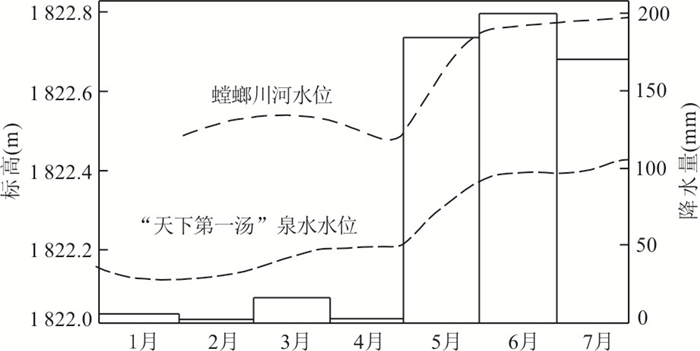
 下载:
下载:

